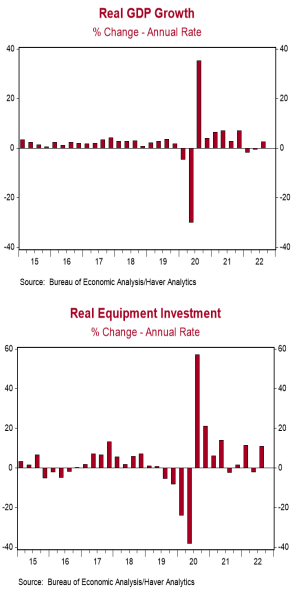- Real GDP increased at a 2.6% annual rate in Q3, beating the consensus expected 2.4%.
- The largest positive contribution for real GDP growth in Q3, by far, came from net exports. Personal consumption, business investment in equipment, government purchases, and business investment in intellectual property were also positive. The largest drags on Q3 GDP growth were home building, inventories, and commercial construction.
- Personal consumption, business fixed investment, and home building, combined, rose at a 0.1% annual rate in Q3.
- The GDP price index increased at 4.1% annual rate in Q3 and is up 7.0% from a year ago. Nominal GDP (real GDP plus inflation) rose at a 6.7% annual rate in Q3 and is up 9.0% from a year ago.
Implications:
Real GDP growth in the third quarter supports our case the economy is not yet in recession, but also signals trouble ahead. Real GDP grew at a moderate 2.6% annual rate in Q3, beating consensus expectations. The growth in the third quarter was led by net exports, particularly in the goods sector, where exports surged and imports fell. However, don’t expect that to continue. The dollar has strengthened substantially versus other major currencies and so will limit future purchases by foreigners while making foreign goods relatively inexpensive for Americans. Real personal consumption was also up in Q3, but at a relatively tepid 1.4% annual rate. Moving forward, it’s hard to be optimistic about growth in consumer purchasing power when “real” (inflation-adjusted) earnings are falling and consumers have reduced the extra balances they had in bank accounts due to massive government stimulus checks in 2020-21. We like to follow personal consumption, business investment, and home building, combined, which we call “core” GDP. This excludes the effect on real GDP of government purchases, inventories, and international trade, all of which are very volatile from quarter to quarter and which are hard for the US to rely on for long-term growth. The problem is that although overall real GDP increased at a 2.6% annual rate in Q3, core GDP rose at a meager 0.1% pace. That’s a growth rate in core GDP that we usually see just before, during, or just after recessions. No bueno. The construction industry already appears to be in a recession of its own. Home building declined at a 26.4% annual rate in Q3, the sixth consecutive quarterly drop and the largest decline since COVID first hit the US. Commercial construction fell at a 15.4% annual rate, also the sixth consecutive negative quarter and the weakest since COVID first hit. Meanwhile, inflation remains a problem. GDP prices rose at a 4.1% annual rate in Q3 and are up 7.0% from a year ago. Nominal GDP – real GDP growth plus inflation – rose at a 6.7% annual rate in Q3 and is up 9.0% from a year ago. These figures signal that monetary policy still needs to tighten to bring inflation back down and a monetary policy tight enough to do that is likely to eventually cause a recession.





